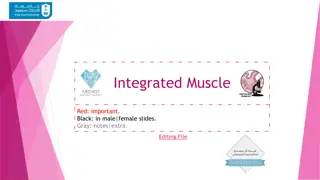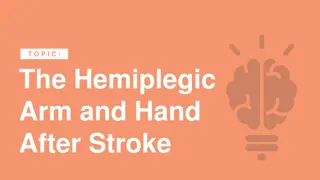Understanding Spasticity and Muscle Tone Disorders
Spasticity is a motor disorder characterized by increased muscle tone and exaggerated reflexes, typically associated with upper motor neuron lesions. This article explains the differences between upper and lower motor neuron lesions, the neurophysiology of spasticity, causes, effects, and treatments to reduce spasticity. It also covers muscle tone, rigidity, and dystonia, providing a comprehensive overview of these conditions.
Download Presentation

Please find below an Image/Link to download the presentation.
The content on the website is provided AS IS for your information and personal use only. It may not be sold, licensed, or shared on other websites without obtaining consent from the author. Download presentation by click this link. If you encounter any issues during the download, it is possible that the publisher has removed the file from their server.
E N D
Presentation Transcript
SPASTICITY AND INCREASED MUSCLE TONE Prof. Syed Shahid Habib MBBS DSDM FCPS Professor Dept. of Physiology King Saud University Note: Pure corticospinal tract lesion cause hypotonia instead of spasticity The reason is that pure pyramidal tract lesion is very very rare, and spasticity is due to loss of inhibitory control of extrapyramidal tracts.
OBJECTIVES At the end of this lecture you should be able to Define spasticity ,rigidity and dystonia Describe the neurophysiology of spasticity Describe the features of upper and lower motor neuron lesions Describe the causes of spaticity Enumarate the effects of spasticity List the treatments to reduce spasticity
MUSCLE TONE The resistance of a muscle to stretch is often referred to as its tone or tonus. If the motor nerve to a muscle is severed, the muscle offers very little resistance and is said to be flaccid. A hypertonic (spastic) muscle is one in which the resistance to stretch is high because of hyperactive stretch reflexes
COMAPRISON BETWEEN UPPER & LOWER MOTOR NEURON LESIONS UMN LESION LMN LESION Paralysis affect movements Wasting not pronounced. Spasticity Muscles hypertonic (Clasp Knife). Tendon reflexes increased. Superficial reflexes diminished Babinski s sign +ve, Individual muscle or group of muscles are affected. Wasting pronounced. Flaccidity. Muscles hypotonic. Tendon reflexes diminished or absent. Superficial reflexes often unaltered.
What is Spasticity? Spasticity is a motor disorder characterized by a velocity-dependant increase in tonic stretch reflexes with exaggerated tendon jerk, resulting from hyperexcitability of the stretch reflex James Lance (1980) https://pgblazer.com/wp-content/uploads/2010/12/Pocket-knife-300x225.jpg In UMN lesions Spasticity is of Clasp Knife Type Rigidity is increased neural activity throughout the range of muscle movement and is not velocity dependent. Rigidity is present in both agonist and antagonist muscles. It is often associated with basal ganglia disease such as Parkinson s disease
https://encrypted-tbn2.gstatic.com/images?q=tbn:ANd9GcS-h570Gcj4MS1QCUDLsEJFMwRXvVWOsShmlndncUMue8BQ1uuY7KdqQuQdhttps://encrypted-tbn2.gstatic.com/images?q=tbn:ANd9GcS-h570Gcj4MS1QCUDLsEJFMwRXvVWOsShmlndncUMue8BQ1uuY7KdqQuQd Rigidity in Parkinsonism Lead-pipe rigidity . Passive movement of an extremity meets with a constant dead feeling resistance like a lead pipe throughout the range of movement. Sometimes a series of catches takes place during passive motion like a cogwheel https://encrypted-tbn1.gstatic.com/images?q=tbn:ANd9GcTPmVQST_Im4nRBmp1LDOWl4E311EqSQgsCxFcAUcU-u7_obH-Qqfmxy8oA Cog-wheel rigidity In cogwheel rigidity one feels that resistance varies rhythmically when applying a passive movement. It is because of an underlying resting tremor associated with rigidity.
CAUSES OF SPASTICITY A-(UMNS) syndrome include : (1) Cerebral palsy (2) Stroke (3) Spinal cord injury (4) Multiple Sclerosis (5) Acqiured brain injury ( trauma , etc ) B-Parkinsonism C- Decerebrate & decorticate rigidity Patients complain of pain, stiffness & inability to relax Prolonged stiffness leads to bone & joint deformities with disability and contractures & its consequences
Support of Body Against Gravity is the role of the Reticular and Vestibular Nuclei Pontine Reticular System. Transmit excitatory signals downward into the cord through the pontine reticulospinal tract in the anterior column of the cord Medullary Reticular System. Transmit inhibitory signals to the same antigravity anterior motor neurons by way of a different tract, the medullary reticulospinal tract, located in the lateral column of cord Decerebrate rigidity results from blockage of normally strong input to the medullary reticular nuclei from the cerebral cortex, the red nuclei, and the basal ganglia. Medullary reticular inhibitor system becomes nonfunctional Pontine excitatory system becomes overactive
Decerebrate Rigidity Upper Pontine damage Decorticate Rigidity Upper midbrain damage
Mechanism of Spasticity When Central Nervous System Lesion occurs Hypotoncity Alpha Lower motor neuron Days to weeks later Denervation hypersensitivity Alpha lower motor neurons lower threshold An increase in the number of Ach receptors Pure corticospinal tract lesion cause hypotonia instead of spasticity The reason is that pure pyramidal tract lesion is very very rare, and spasticity is due to loss of inhibitory control of extrapyramidal tract.
Increased Gamma efferent discharge is the main cause of increased muscle tone.
Ashworth Scale Physical therapist need clarity to realize how spasticity can have affects on a patients ability to move A valid & reliable measure scale for spasticity
Spasticity vs Dystonia Increased muscle tone Resistance to passive muscle stretch at a joint Velocity and joint-angle dependent Has to be palpated ie you need to lay on hands Other features: clonus, increased reflexes, upgoing plantars Sustained and repititive muscle contractions & abnormal postures Visible Involuntary movements Suggests active rather than passive movements Not usually velocity- dependent Dependent on mental state: alertness, emotion
Interventions/Treatments Effective Treatments for reducing Spasticity PT Intervention Electrical and Functional Electrical Stimulation Casting Mental Imagery Pharmacological Interventions Surgery
CEREBRAL PALSY (CP) CP includes disorders apparent at birth or in childhood due to intra- uterine or neonatal brain damage mainly motor control centers; deficits are non-progressive hypoxia in utero and/or during parturition neonatal cerebral haemorrhage and/or infarction trauma, neonatal or during parturition prolonged seizures status epilepticus Hypoglycaemia kernicterus
MULTIPLE SCLEROSIS Auto-immune demyelinating disease , in which the body's own immune system attacks the myelin sheath of nerves mainly of brain, spinal cord & optic nerve Demyelination affects saltatory conduction and cause muscle weakness& wasting. Onset usually in young adults (F>M) When it causes demyelination of descendindg motor tracts in the brainstem & spinal cord , the patient develops spasticity and other signs of UMN lesions . The disease frequently remits and relapses Treated by steroids
STROKE Haemorrhagic stroke & Ischaemic stroke Results in paralysis in the opposite half of the body A lesion in Corona Radiata on one side can cause Monoplegia in a contralateral limb (UL or LL). A lesion in the Internal Capsule on one side may cause Hemiplegia or Hemiparesis on the contralateral side Presents with features of upper motor neuron syndrome UMNL .
Brown Sequard syndrome HEMISECTION OF SPINAL CORD Ipsilateral Loss: Fine touch, Vibration, Proprioception (Dorsal Column) Leg Ataxia (Dorsal Spinocerebellar) Spastic Paresis below lesion (Lat Corticospinal) Flaccid Paralysis (Vent horn destruction) Dermatomal Anesthesia (Dorsal Horn destruction) Contralateral Loss: Loss of pain and temp (lat Spinothalamic) Loss of crude touch and Pressure (Vent Spinothalamic) Minor Contralat Muscle Weakness (Vent Corticospinal) Leg Ataxia (Vent Spinocerebellar)
Complete transection of spinal cord in lower cervical region down in the thoracic region 3 Stages :- A/ Spinal shock ( 2-6 weeks ) B/ Recovery of reflex activity C/ Paraplegia in extension quadriplegia paraplegia (both lower limbs) Voluntary movements and sensations are permanently lost A/ Spinal shock: Immediately following transection there is loss of all sensations (anaesthesia), reflexes, tone (flacciduty) and voluntary movement below the level of the lesion , due to interruption of all sensory and motor tracts. Bladder urinary retention with overflow) and Loss of vasomotor tone occurs causes a fall in blood pressure;
B/ Stage of return of reflex activity due to increase in degree of excitability of the spinal cord neurons Gradual rise of arterial blood pressure Exaggerated tendon reflexes, spasticity, viceral reflexes return (micturition, defecation & erection reflexes) Mass reflex A minor painful stimulus to the skin of the lower limbs causes withdrawal and evoke autonomic reflexes (bladder and rectum emptying, sweating , blood pressure rise) C/ Stage of extensor paraplegia The lower limbs become spastically extended. -Extensor reflexes become exaggerated, as shown by tendon jerks and by the appearance of clonus. -The positive supportive reaction returns and the patient can stand on his feet with appropriate support. The flexor withdrawal reflex and crossed extensor reflex returns























